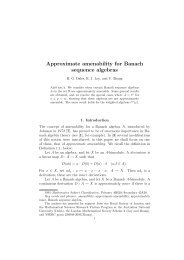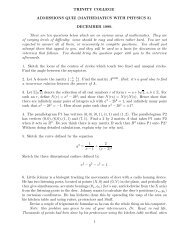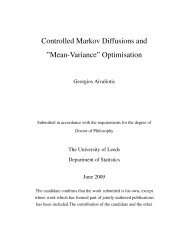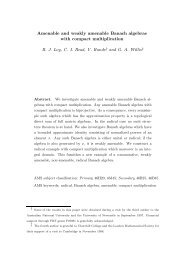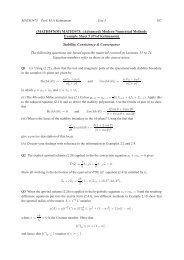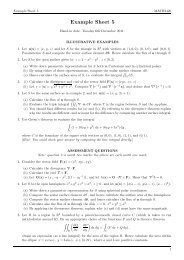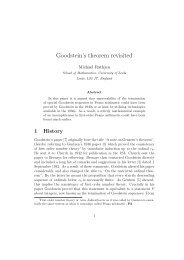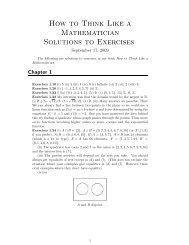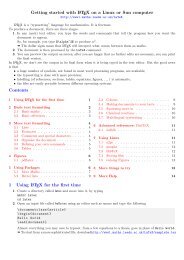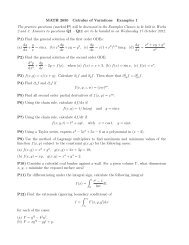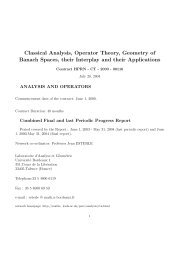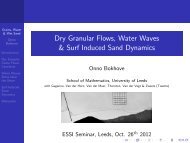A study of time integration schemes for the numerical modelling of ...
A study of time integration schemes for the numerical modelling of ...
A study of time integration schemes for the numerical modelling of ...
You also want an ePaper? Increase the reach of your titles
YUMPU automatically turns print PDFs into web optimized ePapers that Google loves.
A. MALIDI, S. DUFOUR AND D. N’DRI2Rising Drops ProblemreferencedropsTotal Area <strong>of</strong> <strong>the</strong> Drops100 2 4TimeFigure 18. Rising and coalescence <strong>of</strong> two bubbles: mass conservation.from each o<strong>the</strong>r. The non-dimensional groups are given by Re = √ N = 30 and Eo = We = 100.Finally, <strong>the</strong> density ratio is given by = 2 = 1 = 2 and <strong>the</strong> viscosity ratio is = 2 = 1 =2.Figure 17 illustrates <strong>the</strong> de<strong>for</strong>mation and coalescence <strong>of</strong> <strong>the</strong> two rising bubbles at various<strong>time</strong> steps. The shape <strong>of</strong> <strong>the</strong> drops are similar to what we can observe in Reference [28], <strong>the</strong>dierence coming from <strong>the</strong> fact that <strong>the</strong>se results come from 3-D simulations. We observethat coalescence occurs after 29 <strong>time</strong> steps (˜t =3:43). Figure 18 illustrates <strong>the</strong> variation <strong>of</strong> <strong>the</strong>total mass <strong>of</strong> <strong>the</strong> bubbles (non-dimensional area) <strong>for</strong> <strong>the</strong> duration <strong>of</strong> <strong>the</strong> simulation, which isvery small. It is un<strong>for</strong>tunately dicult to nd quantitative results in <strong>the</strong> literature in order toper<strong>for</strong>m an accurate validation <strong>for</strong> this problem.7. CONCLUSIONA <strong>time</strong> <strong>integration</strong> strategy is proposed <strong>for</strong> <strong>modelling</strong> free surface ows in <strong>the</strong> context <strong>of</strong>Eulerian interface capturing. An adaptive second-order accurate backward dierentiation <strong>for</strong>mulais used to discretize <strong>the</strong> transient term <strong>of</strong> <strong>the</strong> Navier–Stokes equations, and <strong>the</strong> implicitmidpoint rule is used <strong>for</strong> <strong>the</strong> transport equation <strong>of</strong> <strong>the</strong> marker variable. The adaptive schemeallows <strong>the</strong> automatic determination <strong>of</strong> a <strong>time</strong>-step size that follows <strong>the</strong> physics <strong>of</strong> <strong>the</strong> problemunder <strong>study</strong>. It is shown that this mixed strategy gives accurate results <strong>for</strong> steady-state freesurface ows, and that it reduces mass loss <strong>for</strong> transient multiuid ows. Such a <strong>study</strong> isnovel to our knowledge. It also seems that it is <strong>the</strong> rst <strong>time</strong> that <strong>the</strong> ABDF scheme wasused in an applied context.In order to keep <strong>the</strong> focus <strong>of</strong> this <strong>study</strong> on <strong>time</strong> <strong>integration</strong> strategies, several components<strong>of</strong> <strong>the</strong> <strong>numerical</strong> model necessary <strong>for</strong> per<strong>for</strong>ming accurate free surface ow simulations wereCopyright ? 2005 John Wiley & Sons, Ltd.Int. J. Numer. Meth. Fluids (in press)



